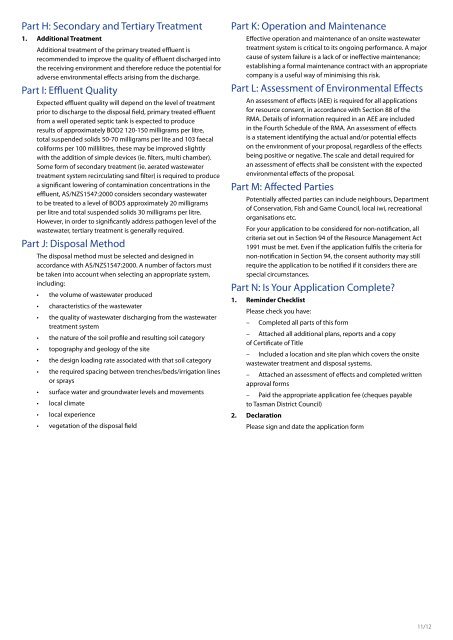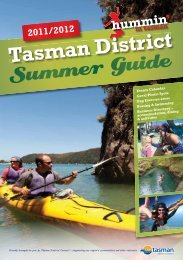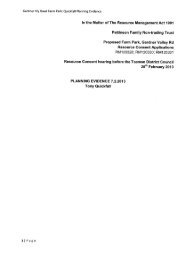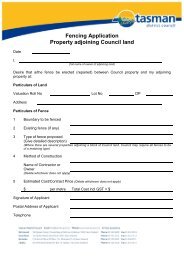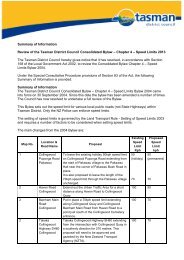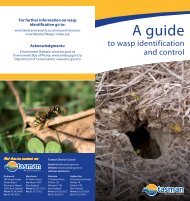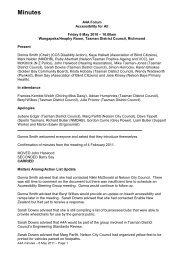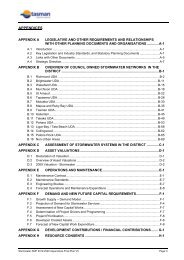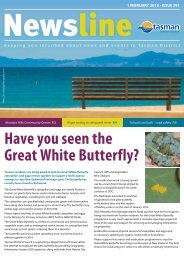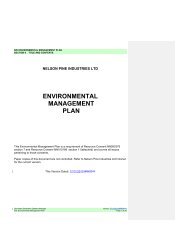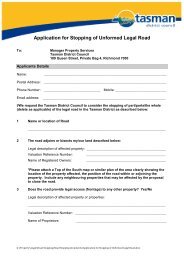Application For Resource Consent To Discharge Domestic ...
Application For Resource Consent To Discharge Domestic ...
Application For Resource Consent To Discharge Domestic ...
You also want an ePaper? Increase the reach of your titles
YUMPU automatically turns print PDFs into web optimized ePapers that Google loves.
Part H: Secondary and Tertiary Treatment<br />
1. Additional Treatment<br />
Additional treatment of the primary treated effluent is<br />
recommended to improve the quality of effluent discharged into<br />
the receiving environment and therefore reduce the potential for<br />
adverse environmental effects arising from the discharge.<br />
Part I: Effluent Quality<br />
Expected effluent quality will depend on the level of treatment<br />
prior to discharge to the disposal field, primary treated effluent<br />
from a well operated septic tank is expected to produce<br />
results of approximately BOD2 120-150 milligrams per litre,<br />
total suspended solids 50-70 milligrams per lite and 103 faecal<br />
coliforms per 100 millilitres, these may be improved slightly<br />
with the addition of simple devices (ie. filters, multi chamber).<br />
Some form of secondary treatment (ie. aerated wastewater<br />
treatment system recirculating sand filter) is required to produce<br />
a significant lowering of contamination concentrations in the<br />
effluent, AS/NZS1547:2000 considers secondary wastewater<br />
to be treated to a level of BOD5 approximately 20 milligrams<br />
per litre and total suspended solids 30 milligrams per litre.<br />
However, in order to significantly address pathogen level of the<br />
wastewater, tertiary treatment is generally required.<br />
Part J: Disposal Method<br />
The disposal method must be selected and designed in<br />
accordance with AS/NZS1547:2000. A number of factors must<br />
be taken into account when selecting an appropriate system,<br />
including:<br />
• the volume of wastewater produced<br />
• characteristics of the wastewater<br />
• the quality of wastewater discharging from the wastewater<br />
treatment system<br />
• the nature of the soil profile and resulting soil category<br />
• topography and geology of the site<br />
• the design loading rate associated with that soil category<br />
• the required spacing between trenches/beds/irrigation lines<br />
or sprays<br />
• surface water and groundwater levels and movements<br />
• local climate<br />
• local experience<br />
• vegetation of the disposal field<br />
Part K: Operation and Maintenance<br />
Effective operation and maintenance of an onsite wastewater<br />
treatment system is critical to its ongoing performance. A major<br />
cause of system failure is a lack of or ineffective maintenance;<br />
establishing a formal maintenance contract with an appropriate<br />
company is a useful way of minimising this risk.<br />
Part L: Assessment of Environmental Effects<br />
An assessment of effects (AEE) is required for all applications<br />
for resource consent, in accordance with Section 88 of the<br />
RMA. Details of information required in an AEE are included<br />
in the Fourth Schedule of the RMA. An assessment of effects<br />
is a statement identifying the actual and/or potential effects<br />
on the environment of your proposal, regardless of the effects<br />
being positive or negative. The scale and detail required for<br />
an assessment of effects shall be consistent with the expected<br />
environmental effects of the proposal.<br />
Part M: Affected Parties<br />
Potentially affected parties can include neighbours, Department<br />
of Conservation, Fish and Game Council, local iwi, recreational<br />
organisations etc.<br />
<strong>For</strong> your application to be considered for non-notification, all<br />
criteria set out in Section 94 of the <strong>Resource</strong> Management Act<br />
1991 must be met. Even if the application fulfils the criteria for<br />
non-notification in Section 94, the consent authority may still<br />
require the application to be notified if it considers there are<br />
special circumstances.<br />
Part N: Is Your <strong>Application</strong> Complete?<br />
1. Reminder Checklist<br />
Please check you have:<br />
– Completed all parts of this form<br />
– Attached all additional plans, reports and a copy<br />
of Certificate of Title<br />
– Included a location and site plan which covers the onsite<br />
wastewater treatment and disposal systems.<br />
– Attached an assessment of effects and completed written<br />
approval forms<br />
– Paid the appropriate application fee (cheques payable<br />
to Tasman District Council)<br />
2. Declaration<br />
Please sign and date the application form<br />
11/12


